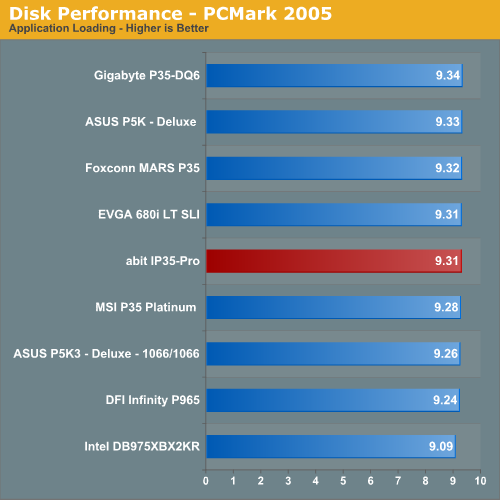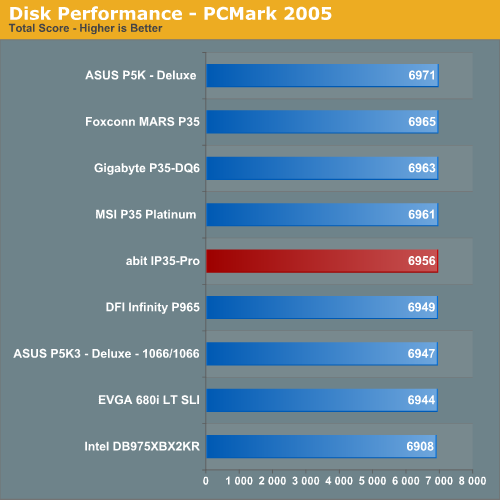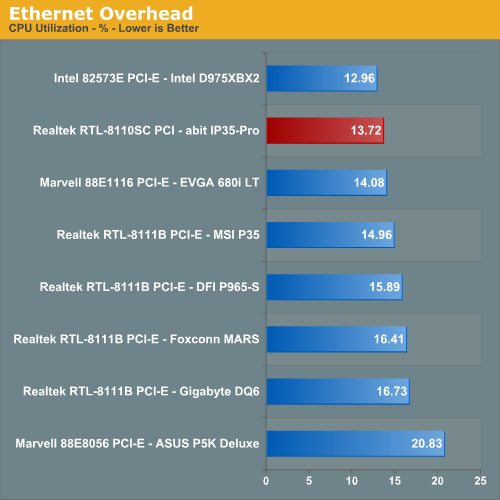abit IP35-Pro: Houston, We Have a Winner
by Gary Key on November 1, 2007 7:00 AM EST- Posted in
- Motherboards
Disk Controller Performance
We have utilized the Intel iPEAK test for the past few years to measure "pure" hard disk or controller performance on Windows XP. Unfortunately, iPEAK is not compatible with Vista so we will utilize two sections of the HDD test suite within PCMark05 for comparative hard disk or controller scores until our Vista hard disk test suite is ready.
This particular test suite provides a mixture of actual application results and specific read/write percentages within these programs. The program utilizes the RankDisk application within the Intel iPEAK SPT suite of tools to record a trace of disk activity during usage of real world applications. PCMark05 replays these traces to generate performance measurements based upon the actual disk operations within each application. The HDD test suite contains 53% read and 47% write operations with each trace section utilizing varied amounts of read or write operations. Additional information about the test suite is available in PDF format.



The performance pattern in these tests indicates what we witnessed in actual application testing. In tests that are heavily dependent on the storage system, the abit board performs very well with consistent results near the top of the test group in our individual application tests. However, the board finished in the middle of the pack in the total score results as it fell behind in the Window's XP startup test when compared to the boards.
Ethernet Performance
LAN performance is also an area worth looking at, as these boards might be serving up media to the rest of the house. All of these boards utilize PCI or PCI Express based controllers with the only difference being the supplier of the core logic.
The Windows 2000 Driver Development Kit (DDK) includes a useful LAN testing utility called NTttcp. We used the NTttcp tool to test Ethernet throughput and the CPU utilization of the various Ethernet Controllers used on the Intel motherboards. We set up one machine as the server - in this test, an Intel system with an Intel CSA Gigabit LAN connection. Intel CSA has a reputation for providing fast throughput and is a logical choice for our Gigabit LAN server.
On the server side, we used the following Command Line as suggested by the VIA whitepaper on LAN testing:
Ntttcpr -m 4,0,‹server IP› -a 4 -l 256000 -n 30000
On the client side (the motherboard under test), we used the following Command Line:
Ntttcps -m 4,0,‹client IP› -a 4 -l 256000 -n 30000
At the conclusion of the test, we capture the throughput and CPU utilization figures from the client screen.


The throughput performance favors the PCI Express Gigabit controllers, but in reality the PCI based Realtek 8110SC controller offers throughput capability that most users will never fully utilize. The CPU utilization numbers favor the Intel controller the Realtek 8110SC offers an attractive alternative plus wide spread OS support. However, the differences are slight and generally not noticeable under normal operating circumstances.
We have utilized the Intel iPEAK test for the past few years to measure "pure" hard disk or controller performance on Windows XP. Unfortunately, iPEAK is not compatible with Vista so we will utilize two sections of the HDD test suite within PCMark05 for comparative hard disk or controller scores until our Vista hard disk test suite is ready.
This particular test suite provides a mixture of actual application results and specific read/write percentages within these programs. The program utilizes the RankDisk application within the Intel iPEAK SPT suite of tools to record a trace of disk activity during usage of real world applications. PCMark05 replays these traces to generate performance measurements based upon the actual disk operations within each application. The HDD test suite contains 53% read and 47% write operations with each trace section utilizing varied amounts of read or write operations. Additional information about the test suite is available in PDF format.



The performance pattern in these tests indicates what we witnessed in actual application testing. In tests that are heavily dependent on the storage system, the abit board performs very well with consistent results near the top of the test group in our individual application tests. However, the board finished in the middle of the pack in the total score results as it fell behind in the Window's XP startup test when compared to the boards.
Ethernet Performance
LAN performance is also an area worth looking at, as these boards might be serving up media to the rest of the house. All of these boards utilize PCI or PCI Express based controllers with the only difference being the supplier of the core logic.
The Windows 2000 Driver Development Kit (DDK) includes a useful LAN testing utility called NTttcp. We used the NTttcp tool to test Ethernet throughput and the CPU utilization of the various Ethernet Controllers used on the Intel motherboards. We set up one machine as the server - in this test, an Intel system with an Intel CSA Gigabit LAN connection. Intel CSA has a reputation for providing fast throughput and is a logical choice for our Gigabit LAN server.
On the server side, we used the following Command Line as suggested by the VIA whitepaper on LAN testing:
Ntttcpr -m 4,0,‹server IP› -a 4 -l 256000 -n 30000
On the client side (the motherboard under test), we used the following Command Line:
Ntttcps -m 4,0,‹client IP› -a 4 -l 256000 -n 30000
At the conclusion of the test, we capture the throughput and CPU utilization figures from the client screen.


The throughput performance favors the PCI Express Gigabit controllers, but in reality the PCI based Realtek 8110SC controller offers throughput capability that most users will never fully utilize. The CPU utilization numbers favor the Intel controller the Realtek 8110SC offers an attractive alternative plus wide spread OS support. However, the differences are slight and generally not noticeable under normal operating circumstances.










29 Comments
View All Comments
Odeen - Thursday, November 1, 2007 - link
In this day and age, PCI LAN = fail.Dual PCI LAN = double fail.
Realtek ANYTHING does not belong on a board that advertises itself as a "Pro"
Whatever happened to the good old days where the south bridge had a MAC that just needed a PHY to have a network connection that was completely independent of other external buses? I know the ATI/AMD RD600 doesn't have a MAC and requires an external network adapter, the ICH9 has a gigabit MAC, and requires merely an Intel 82566 PHY chip to have a gigabit Ethernet connection.
For that matter, who here uses dual NICs? Please raise your hands and tell me what you use them for. Seems like a waste of power to use a computer for internet connection sharing, in the day and age of $25 wireless routers....
Mekreluk - Thursday, November 1, 2007 - link
Right, so let me get this right.You give the IP35-Pro a gold award, and the DFI P35-TR2 a silver award?
The IP35-Pro had bigger vDroop, reaches a lower FSB with a Quad and scores a mark above the DFI?
I'm not disputing that it's a good board, after all it's cheaper than the DFI and has uGuru but these motherboards are for enthusiasts. The users who chuck the most expensive, best performing hardware into their online carts without a second thought.
So, I'm thinking a Vauxhall Zafira should score more than a Lotus Elise because hey! It's slower, costs less and can fit 7 people in it.
Add to that the fact the DFI P35 review walks all over the IP35-Pro one as it's also a more in depth guide into it's overclocking with the GTLREF settings etc.
yyrkoon - Friday, November 2, 2007 - link
It has been said that the vdroop on these boards is associated with inexperienced users *not* using a different 12v rail for the 4 pin PCIe AUX power connection. The only vdroop I had with my IP35-E and E6550 @ 3.33Ghz was a very small MCH vdroop, which was easily corrected in the BIOS by bumping the MCH voltage up one notch. I am also using a Power supply that is known to work well with the IP35 series.The award for this board is well warranted in my opinion, and I cannot help but wonder exactly how stable that DFI PoS is, and how easy it is to setup. I could care less if it runs at a slightly higher external clock if it is not stable, or is extremely hard to set up. ANYONE with half a brain can setup the IP35 boards with a reasonable OC in about 1 minute, and these boards work 100% out of the box the way they are intended, and are dahmed stable(meaning I have not experienced a single BSoD, or crash since this board made it into my system).
As for the 'bad' ethernet performance, ANYONE who is serious about their ethernet performance is going to be using either an Intel Pro 1000 desktop adapter, or an Intel pro 1000 server adapter, and not some PoS onboard ethernet. As for why dual ports ? Maybe someone wants to run their desktop on multiple subnets ? Ive done it before . . . it can be great for remote booting. Now tying the GbE port(s) to the PCI bus is a serious no no, I will agree with that.
Let me guess . ..you own said DFI P35-TR2 board ? If you like it, fine use it , be happy and quite whining about some review that is 'dis'n' your motherboard . . . and go wonder how serious overclockers on the ABIT forums have hit 4Ghz + with their E6600's on this board.
Mekreluk - Sunday, November 4, 2007 - link
I didn't say the board doesn't warrant the review score, as I said, I know it's a good board but there are users on XS who have gotten a higher clock out of the P35-T2R after migrating from the IP35-Pro.How stable the DFI is? Very stable, it's been described as rock stable by C-N, BrotherEsau, Solarfall who are 3 regular posters in the thread over at XS. I didn't actually own the P35-TR2 when I posted my comment before, I don't actually currently have a PC due to having my PC343B custom modified for a dual water cooling loop. I made my observation on real end user experiences with the board. I've since received my DFI board though.
Bozo Galora - Thursday, November 1, 2007 - link
First of all, these AT mobo reviews are always way late, with endless forum posts by Mr. Key about hourly "bios updates" being emailed to him by manuf. Can't they test their own boards - why do they need a reviewer to spot a bug? Abit doesnt know about Vdroop??? Dont they test firewire thruput?I'm sick of motherboards that work 90%.
And I dont want to hear about buggered up bios for months - when you get a "bought in store" retail board, then review it, other than that, stifle yourself.
You practically sleep with these guys - where's your objectivity? Its not your job to help them bring out a working board. I mean, like they need Gary Key for input - what are THEIR engineers doing all this time?
And why is it after all these years that mobo makers still cannot create a lousy <1MB bios that works right out of the gate.
They are still shoving crap out the door and hoping it flies - eventually.
I say Gary Key must go - get someone who doesnt put out all those "teaser" blurbs. Maybe that's one reason why you only have 422 members online at this moment. Its so annoying.
And FWIW: Abit is skipping the X38
http://my.ocworkbench.com/bbs/showthread.php?%20th...">http://my.ocworkbench.com/bbs/showthread.php?%20th...
Heidfirst - Friday, November 2, 2007 - link
"And FWIW: Abit is skipping the X38http://my.ocworkbench.com/bbs/showthread.php?%20th...">http://my.ocworkbench.com/bbs/showthread.php?%20th...
No, they aren't - in fact IX38 QuadGT DDR2 stock arrived in the UK today.
As for the dual PCI LAN there is a reason & it's a deliberate design decision - it's upto you whether it's right or wrong for you but as Gary said it won't affect the vast majority of people as it's still waaay faster than domestic broadband & also faster than a single hard drive can cope with.
By using PCI LAN on the Pro(the IP35-E & plain IP35 use PCI-E LAN) it means that you can use the x16 PCI-E slot & the x4 PCI-E slot & still have another x1 PCI-E slot active (the last PCI-E lane on the chipset is used for the JMicron) for use with a wifi card, soundcard etc.
Other boards from competitors disable other PCI-E slots when the x16 & x4 are used to their capacity.
Maybe not so important now when there are still relatively few x1 PCI-E cards available (although 1 of course is abit's AirPace wifi) but in a year or 2?
crabnebula - Thursday, November 1, 2007 - link
One of the negatives I've seen about this board in other reviews is its Firewire throughput, which is considerably slower than competitors.See here for example: http://www.bit-tech.net/hardware/2007/07/12/abit_i...">http://www.bit-tech.net/hardware/2007/07/12/abit_i...
This might be of importance to some people who use FireWire devices.
Heidfirst - Thursday, November 1, 2007 - link
there was a BIOS released after that which supposedly addressed the firewire transfer rate issue.crimson117 - Thursday, November 1, 2007 - link
At the start of the review you mentioned a problem with the heatsinks.Is abit planning to fix this? It sounds like kind of a serious thing that the heatsinks don't work properly out of the box in 2 of your 3 boards.
Gary Key - Saturday, November 3, 2007 - link
We have abit to screen their production process and to improve this design. We had one board that the PWM heatsink refused to make decent contact with the components and the other two were close to perfect. It could be manufacturing variations in the heatsink design or just plain bad quality control.